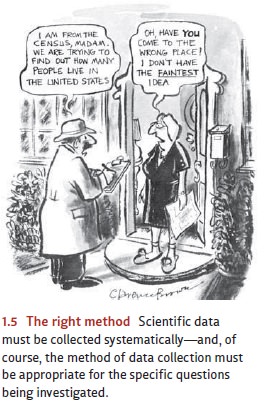Chapter: Psychology: Research Methods
Making Observations: Systematically Collecting Data
Systematically
Collecting Data
Suppose we’ve defined our
question and figured out how to measure our dependent variable. What comes
next? In everyday life, people often try to answer empirical ques-tions by
reflecting on their personal experience. They’ll try to recall cases that seem
rel-evant to the issue being evaluated, and say things like, “What do you mean,
boys are more aggressive? I can think of three girls, just off the top of my
head, who are extremely aggressive.”
This sort of informal “data
collection” may be good enough for some purposes, but it’s unacceptable for
science. For one thing, the “evidence” in such cases is being drawn from
memory—and people’s memories aren’t always accurate. Another problem is that
memories are often selective. We’ll
consider a pattern known as confirmation
bias. This term refers to people’s tendency to recall evidence that
confirms their views more easily than they can recall evidence to the contrary.
So if someone happens to start out with the idea that girls are more
aggres-sive, confirmation bias will lead them to supporting evidence—whether
their initial idea was correct or not.
More broadly, scientists refuse
to draw conclusions from anecdotal
evidence— evidence that involves just one or two cases, has been informally
collected, and is now informally reported. There are many reasons for this
refusal: The anecdotes are often drawn from memory; and, for the reasons just
described, that by itself is a problem. What’s more, anecdotes often report a conclusion drawn from someone’s
observations, but not the observations themselves, and that invites questions
about whether the con-clusion really does follow from the “evidence.” For
example, if someone reports an anec-dote about an aggressive girl, we might
wonder whether the girl’s behavior truly deserved that label—and our
uncertainty obviously weakens the effect of the anecdote.
Perhaps the worst problem with
anecdotal evidence, though, is that the anecdotes may represent exceptions and
not typical cases. This is because, when reporting anec-dotes, people are
likely to overlook the typical cases precisely because they’re familiar and
hence not very interesting. Instead, they’ll recall the cases that stand out
either because they’re extreme or because they don’t follow the usual pattern.
As a result, anec-dotal evidence is often lopsided and misleading.
If we really wanted to compare
boys’ and girls’ aggression, then, how could we avoid all these problems? For a
start, we need to record the data in some neutral and objective way, so there’s
no risk of compromising the quality of our evidence through bias or memory
errors. Second, our data collection has to be systematic (Figure 1.5). We might
want to collect observations from all the boys and all the girls at a
particular play-ground; or perhaps, just to keep our project manageable, we
might observe every tenth child who comes to the playground. Notice that these
will be firsthand observations— we’re not relying on questionable anecdotes.
Notice also that our selection of which children to observe (“every tenth
child”) is not guided by our hypothesis. That way, we can be sure we’re not
just collecting cases that happen to be unusual, or cases that sup-port our
claim. This sort of data collection can be cumbersome, but it will give us data
that we can count on in drawing our conclusions.

Related Topics